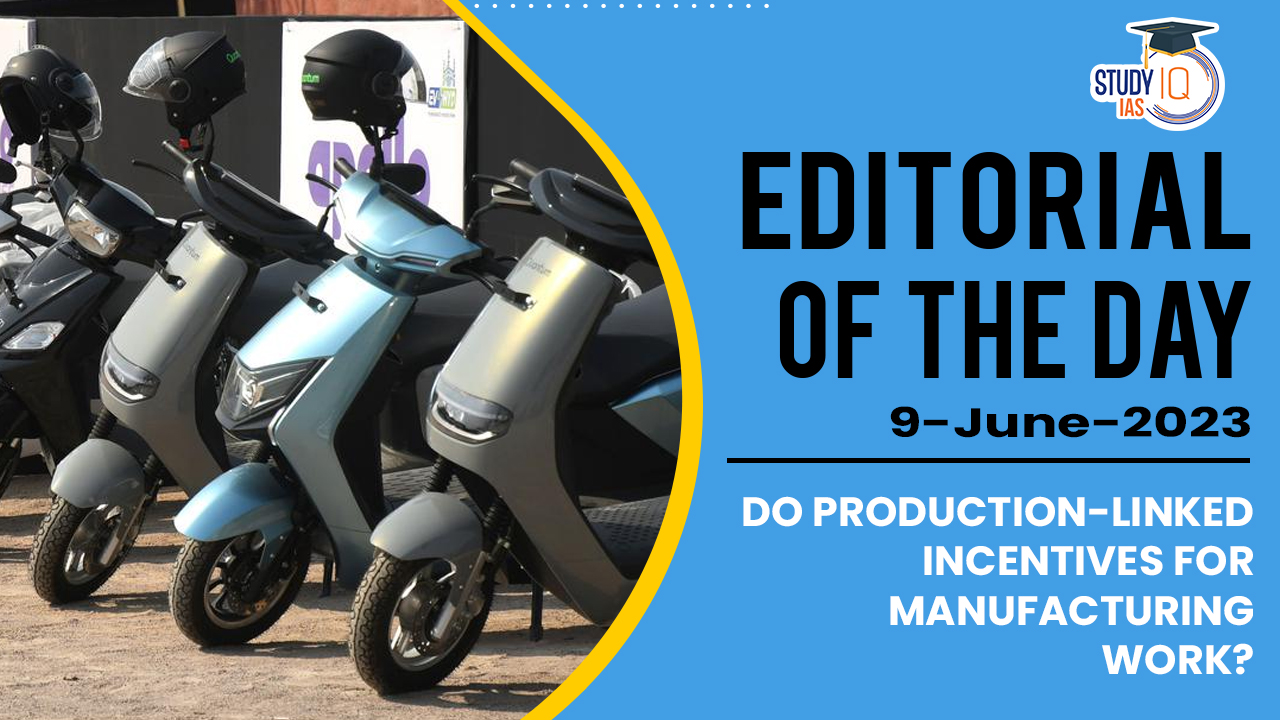Table of Contents
Context: The article discusses the effectiveness of production-linked incentives (PLI) in boosting India’s domestic manufacturing and exports. A former RBI Governor questions the success of the PLI scheme, while the government believes it has been beneficial. In this light, the authors share their perspectives on subsidizing domestic sectors and imposing tariffs on imports. The article highlights the importance of targeting strategic sectors, addressing demand and structural issues, improving infrastructure and education, and reducing bureaucratic control. It also discusses the potential for cronyism and the need for a balanced approach to subsidies.
Background
What is the Production-Linked Incentives (PLI) Scheme?
- It is a central government initiative that provides financial incentives to domestic companies to increase the production and sales of specific products manufactured within the country.
- Objective: The scheme aims to boost domestic manufacturing capacity, promote import substitution, create employment opportunities, and make Indian industries globally competitive.
- Launch: The PLI scheme was initially launched in April 2020 for the electronics manufacturing sector, as part of the government’s Make in India Initiative and Atmanirbhar Bharat (Self-Reliant India) campaign.
- Strategy: The PLI scheme offers a cash incentive for three to five years on the incremental sale of goods manufactured in India over-determined base-year sales.
- Additionally, the identified beneficiaries are required to commit to a certain minimum investment in India.
- Sector covered: So far, the government has announced PLI schemes with an outlay of about Rs 2 lakh crore for as many as 14 sectors including automobile and auto components, electronics and IT hardware, telecom, pharmaceuticals, solar modules, metals and mining, textiles and apparel, white goods, drones, and advanced chemistry cell batteries.
- Performance so far: According to the NITI Aayog, PLI Scheme has created more than three lakh jobs so far and attracted investment worth over Rs 45,000 crore.

Decoding the Editorial
The authors of the article present various arguments both in favor of and against the PLI scheme.
Arguments in favour of the Production-Linked Incentives (PLI) Scheme
- Boosting domestic manufacturing: One author argues that the PLI scheme has been successful in stimulating domestic manufacturing by providing financial incentives to companies. It is seen as a way to encourage companies to increase production and contribute to economic growth.
- Promoting strategic sectors: Author argues that targeting specific strategic sectors, such as semiconductors and electric vehicles, can drive industrialization and development. These sectors are expected to have high future demand and can contribute to job creation and technological advancements.
- Attracting investments: In a globally integrated economy, providing incentives like PLI is seen as necessary to attract both domestic and foreign investments. By offering subsidies or incentives, the government aims to make India a favorable destination for manufacturing and compete with other countries that provide similar benefits.
- Addressing import dependency: The authors highlight the issue of import dependency, particularly in sectors like electronics. The PLI scheme is seen as a means to reduce imports by promoting local manufacturing, thus enhancing self-reliance and reducing trade deficits.
Arguments against the Production-Linked Incentives (PLI) Scheme
- Limited impact on employment generation: Another author argues that the PLI scheme primarily focuses on the organized sector, which has low employment generation due to automation. This raises concerns about the scheme’s effectiveness in addressing the broader issue of unemployment and generating sufficient demand in the economy.
- Risk of cronyism: The author raises concerns about the discretionary nature of subsidies and the potential for cronyism in determining which sectors and companies receive them. Without proper transparency and accountability, there is a risk that subsidies may be allocated based on favoritism or vested interests rather than merit.
- Insufficient focus on demand-side issues: Author emphasizes that addressing the structural problem of low demand should be a priority. Simply providing supply-side incentives like PLI may not be effective in boosting the overall economy if there is a lack of demand, particularly in sectors that cater to mass consumption items.
- Inadequate investment in research and development: The authors point out that Indian businesses have historically invested less in research and development (R&D) compared to other dynamic economies. Hence, a more comprehensive approach is needed to encourage domestic R&D investments and build internal technological capabilities instead of relying heavily on importing technology.
Beyond the Editorial: India’s Manufacturing Sector at a Glance
- Economic contribution: Currently, manufacturing accounts for about 15 percent of the country’s GDP.
- Global share: India is the sixth-largest manufacturing economy in the world and contributes 3.1% to the world GDP.
- Employment: Manufacturing sector in India employs about 12% of the total labour force. Overall, more than 30 million people are employed in the sector (organized and unorganized).
- Capacity utilization: In the second quarter of FY22, capacity utilization in India’s manufacturing sector stood at 72.0%, indicating significant recovery in the sector.
- It is measured by the Reserve Bank of India (RBI). It indicates not only the production levels of companies but also the potential for future investment.
- Share in exports: Manufactured goods consist of almost 65% of Indian merchandise exports or around 43% of total exports. Manufacturing exports saw a CAGR of more than 15 per cent to touch $418 billion in fiscal year 2021-22.
- FDI Share: Manufacturing sector obtained 35% of all FDI inflow. India is rapidly emerging as a preferred country for foreign investments in the manufacturing sector. FDI Equity inflow in Manufacturing Sectors have increased by 76% in FY 2021-22 (USD 21.34 billion) compared to previous FY 2020-21 (USD 12.09 billion).
- The Global Manufacturing Risk Index 2021: India has overtaken the United States (US) to become the second-most sought-after manufacturing destination globally.


 Daily Quiz 01 July 2025
Daily Quiz 01 July 2025
 China, Pakistan and Bangladesh Trilatera...
China, Pakistan and Bangladesh Trilatera...
 US Pulls Funding from GAVI-Global Vaccin...
US Pulls Funding from GAVI-Global Vaccin...





















